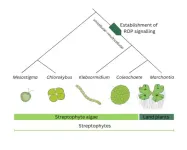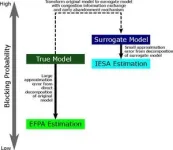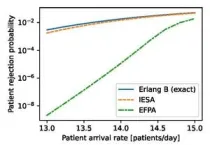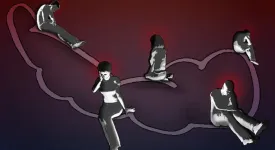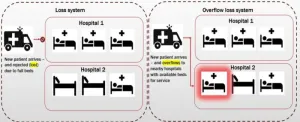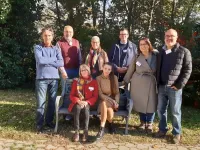(Press-News.org) Plants regulate their development with a distinct group of molecular players. ROP proteins, a group of plant-specific proteins, are known to control plant tissue formation. Now, Hugh Mulvey and Liam Dolan at the GMI show that ROP proteins evolved at the transition between unicellular and multicellular plant life. The findings are published on November 30 in the journal Current Biology.
Being non-mobile, plants follow a very different lifestyle from us animals. To grow and develop, plants also need a distinct set of molecular players and pathways that orchestrate and fine tune tissue and organ formation. One such pathway involves ROP proteins, a subfamily of the RHO GTPase family of proteins found in most eukaryotes. The ROP subfamily, however, is distinct from proteins in the RHO GTPase family in animals and fungi, and only present in plants.
In land plants, as Hugh Mulvey, postdoctoral fellow, and Liam Dolan, senior group leader at the Gregor Mendel Institute (GMI) of the Austrian Academy of Sciences – previously established, ROP proteins are essential to regulate three-dimensional tissue development and organ formation. In their new publication Mulvey and Dolan sought to pinpoint the time at which ROP signaling evolved – and found that this coincides with the evolution of multicellularity in plants. “ROP proteins are different from proteins in the RHO GTPase family found in animals and fungi. However, it was unclear when ROP signaling evolved”, says Mulvey. “We asked: Is ROP only found in land plants, or did it arise earlier in the algal ancestor of land plants?”
Striking similarity in sequence and function
To probe ROP’s evolution, the researchers combined phylogenetics and genetic complementation studies. First, Mulvey compared the ROP protein sequence in land plants to the sequence in other streptophytes, the lineage to which land plants belong. He found the sequence of ROP to be highly similar between Marchantia, a model land plant, and the multicellular streptophyte algae Klebsormidium and Coleochaete. However, the ROP sequence differed in unicellular and colonial streptophyte algae, such as Mesostigma and Chlorokybus. “The ROP protein sequence turned out to be highly conserved between land plants and streptophyte algae, excluding Mesostigma and Chlorokybus”, Mulvey concludes.
Next, the researchers asked whether only the protein’s sequence is conserved, or whether ROP proteins from multicellular streptophyte algae and land plants also function similarly. Marchantia serves as the perfect model for the complementation studies required to address this question. These studies involve replacing a knocked-out protein from one species with a related protein, known as a homolog, from another species. Unlike Arabidopsis, which has 11 ROP genes, Marchantia has just one ROP gene. This allows researchers to examine the ROP gene in isolation in Marchantia.
For the complementation experiments, Mulvey conducted experiments in Marchantia plants that lacked the native ROP protein and introduced the ROP homolog from three different algal species. When the ROP homolog from Coleochaete or Klebsormidium, which are multicellular algae, was inserted into the Marchantia rop mutant, it grew like plants with the native Marchantia ROP protein. This demonstrated that the ROP homologs from Coleochaete or Klebsormidium can function in place of the Marchantia ROP protein. However, when the ROP homolog from Chlorokybus was used, the Marchantia plants did not develop normally. “It’s not just the ROP sequence that is similar between multicellular filamentous streptophyte algae and land plants, but also the function.”
On the road to a multicellular body plan
Combining phylogenetics and genetic complementation studies, Mulvey and Dolan find that ROP signaling is widely conserved in the streptophyte branch of plants: “ROP has been highly conserved since the last common ancestor of filamentous streptophyte algae and land plants”, says Dolan. “This coincides with the point in evolution at which multicellularity evolved in this lineage.”
So far, the genetic basis behind the transition from a unicellular to a multicellular way of living has been little understood. The shift from a single cell to a multicellular filamentous body plan required the development of mechanisms that limit cell growth and division to a single direction, and keep cells sticking together after division. The timing of ROP signaling evolution coincides with the point in evolution at which this transition is thought to have taken place, Mulvey adds. “Since ROP proteins in land plants are known to control polarized cell growth and the orientation of cell division, we speculate that the evolution of ROP signaling in this lineage might have contributed to the evolution of multicellularity and the morphological transition to a multicellular body plan.”
END
ROP signaling: Origin at dawn of multicellular plant life
2023-11-30
ELSE PRESS RELEASES FROM THIS DATE:
Twin research indicates that that a vegan diet improves cardiovascular health
2023-11-30
In a study with 22 pairs of identical twins, Stanford Medicine researchers and their colleagues have found that a vegan diet improves cardiovascular health in as little as eight weeks.
Although it’s well-known that eating less meat improves cardiovascular health, diet studies are often hampered by factors such as genetic differences, upbringing and lifestyle choices. By studying identical twins, however, the researchers were able to control for genetics and limit the other factors, as the twins grew up in the same households ...
A mineral produced by plate tectonics has a global cooling effect, study finds
2023-11-30
MIT geologists have found that a clay mineral on the seafloor, called smectite, has a surprisingly powerful ability to sequester carbon over millions of years.
Under a microscope, a single grain of the clay resembles the folds of an accordion. These folds are known to be effective traps for organic carbon.
Now, the MIT team has shown that the carbon-trapping clays are a product of plate tectonics: When oceanic crust crushes against a continental plate, it can bring rocks to the surface that, over ...
Age disparities in prevalence of anxiety and depression among adults during the pandemic
2023-11-30
About The Study: In this study of 3 million U.S. adults, anxiety and depression were significantly higher among adults ages 18 to 39 compared with adults age 40 and older during the COVID-19 pandemic. Less favorable economic conditions and responses to social upheaval may have contributed to young adults’ worse mental well-being. These findings suggest a need for greater mental health care and economic policies targeted toward younger adults.
Authors: Sarah Collier Villaume, Ph.D., of Northwestern University in Evanston, ...
Structural racism and lung cancer risk
2023-11-30
About The Study: The findings of this study suggest that structural racism must be considered as a fundamental contributor to the unequal distribution of lung cancer risk factors and thus disparate lung cancer risk across different racial and ethnic groups. Additional research is needed to better identify mechanisms contributing to inequitable lung cancer risk and tailor preventive interventions.
Authors: Sidra N. Bonner, M.D., M.P.H., M.Sc., of the University of Michigan in Ann Arbor, is the corresponding author.
To access the embargoed study: Visit our For The Media website ...
Traumatic memories are represented differently than regular sad memories in the brains of people with PTSD, new research shows
2023-11-30
A new analysis of the brain activity of people with post-traumatic stress disorder (PTSD) is the first to reveal that traumatic memories are represented in the brain in an entirely different way than sad autobiographical memories.
This finding supports the notion that traumatic memories in PTSD are an alternate cognitive entity that deviates from regular memory, and may provide a biological explanation for why the recall of traumatic memories often displays as intrusions that differ profoundly from “regular” negative memories for patients with PTSD.
The study, ...
Study reveals distinct brain activity triggered by memories of trauma
2023-11-30
New Haven, Conn. — It is well known that people who have lived through traumatic events like sexual assault, domestic abuse, or violent combat can experience symptoms of post-traumatic stress disorder (PTSD), including terrifying flashbacks, severe anxiety, and uncontrollable thoughts about the incident. But what exactly happens in the brains of PTSD patients as they recall these traumatic events? Are they remembered the same way as, say, the loss of a beloved pet — or, for that matter, a relaxing walk on the beach?
A new study co-led by Yale researchers finds that the brain activity triggered by recollections of traumatic experiences ...
Armed to the hilt: Study solves mystery behind bacteria’s extensive weaponry
2023-11-30
New study tackles the mystery of why bacteria often carry diverse ranges of weapons.
The findings show that different weapons are best suited to different competition scenarios.
Short-range weapons help bacteria to invade established communities; long-range weapons are useful once established.
A new study led by the University of Oxford has shed light on why certain species of bacteria carry astonishing arsenals of weapons. The findings, published today in the journal Nature Ecology & Evolution, could help us to engineer microbes that can destroy deadly pathogens, reducing our reliance on antibiotics.
Many species of bacteria possess ...
Gladstone team uncovers why maternal diabetes predisposes babies to heart defects
2023-11-30
SAN FRANCISCO—November 30, 2023—When women with diabetes become pregnant, they face not only the typical challenges of pregnancy and impending parenthood, but also a scary statistic: they’re five times more likely to have a baby with a congenital heart defect.
Researchers at Gladstone Institutes have now discovered why that is, identifying the cells and molecules that go awry in the developing hearts of fetuses in women with diabetes. They found that a small subset of cells destined to become part of the heart’s aorta and pulmonary artery have unusually high levels of retinoic acid activity, which coaxes them to behave more like cells found ...
CityU researchers tackle a century-old teletraffic challenge to enhance medical and public service efficiency
2023-11-30
Efficiently meeting the growing demand for public services in metropolitan areas has long been a persistent challenge. A research team at City University of Hong Kong (CityU) has developed a novel performance evaluation method, which marks a major breakthrough in tackling a century-old problem of evaluating blocking probabilities in queueing systems with overflow, providing ways to allocate limited resources better. With the remarkable advances in computational efficiency and accuracy, the method has great potential to optimise the performance of numerous telecommunication networks and even medical care systems, ultimately enhancing ...
Bringing asteroids to class: COSPAR joins new Erasmus+ program
2023-11-30
COSPAR and the Erasmus+ Education Programme
COSPAR’s participation in Erasmus+ programmes is part of the COSPAR Panel on Education’s new approach to its mission of developing “means and media to encourage and spread space-related education”. The StudenTs As plaNetary Defenders (StAnD) project aims to engage primary and secondary school students in the subject of asteroids, meteors, and planetary defence.
The 36-month StudenTs As plaNetary Defenders (StAnD) programme brings asteroids, comets, meteors and meteorites to the classroom using carefully prepared activities and experiments. The programme includes the installation of meteor detection cameras in participating ...
